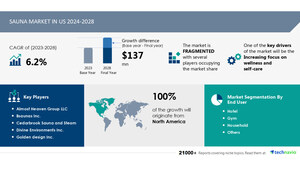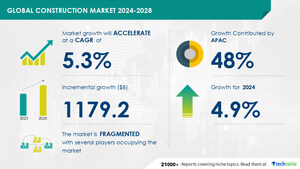NEW YORK, June 28, 2024 /PRNewswire/ -- The global magneto resistive ram (MRAM) market size is estimated to grow by USD 1.62 billion from 2024-2028, according to Technavio. The market is estimated to grow at a CAGR of about 32.16% during the forecast period. Low-power consumption is driving market growth, with a trend towards integration of mram in the smartphone. However, memory density issue poses a challenge. Key market players include ARCO INC., Avalanche Technology Inc., Crocus Nano Electronic LLC, Everspin Technologies Inc., Fujitsu Ltd., Honeywell International Inc., IMEC Inc., KLA Corp., MEMTECH, Numem Inc., NVE Corp., NXP Semiconductors NV, Renesas Electronics Corp., Samsung Electronics Co. Ltd., SK hynix Co. Ltd., SPIN MEMORY INC., SRAM and MRAM Group, Taiwan Semiconductor Manufacturing Co. Ltd., Teledyne Technologies Inc., and Yole Developpement SA.
Get a detailed analysis on regions, market segments, customer landscape, and companies- View the snapshot of this report
Magneto Resistive Ram (MRAM) Market Scope |
|
Report Coverage |
Details |
Base year |
2023 |
Historic period |
2018 - 2022 |
Forecast period |
2024-2028 |
Growth momentum & CAGR |
Accelerate at a CAGR of 32.16% |
Market growth 2024-2028 |
USD 1625.7 million |
Market structure |
Fragmented |
YoY growth 2022-2023 (%) |
24.43 |
Regional analysis |
North America, APAC, Europe, South America, and Middle East and Africa |
Performing market contribution |
APAC at 47% |
Key countries |
US, China, Germany, Canada, and Japan |
Key companies profiled |
ARCO INC., Avalanche Technology Inc., Crocus Nano Electronic LLC, Everspin Technologies Inc., Fujitsu Ltd., Honeywell International Inc., IMEC Inc., KLA Corp., MEMTECH, Numem Inc., NVE Corp., NXP Semiconductors NV, Renesas Electronics Corp., Samsung Electronics Co. Ltd., SK hynix Co. Ltd., SPIN MEMORY INC., SRAM and MRAM Group, Taiwan Semiconductor Manufacturing Co. Ltd., Teledyne Technologies Inc., and Yole Developpement SA |
Market Driver
MRAM technology, which retains data without power and offers faster read-write speeds than Flash and EEPROM, is poised to enter the smartphone market during the forecast period. Companies like Apple are expected to adopt MRAM chips due to its data stability and low power consumption. MRAM's significance lies in its potential to support real-time vision processing and 3D mapping in next-generation devices. With approximately 2 billion smartphone users worldwide in 2023, the integration of MRAM in smartphones is anticipated to drive the global MRAM market's growth. Key players such as Avalanche Technology Inc., Everspin Technologies Inc., Renesas Electronics Corp., Honeywell International Inc., and Teledyne Technologies Inc. Are conducting research on MRAM technology, with Freescale Semiconductor (now NXP Semiconductors NV) leading the way for consumer applications.
The Magneto Resistive Random Access Memory (MRAM) market is experiencing significant growth due to its advanced features and increasing demand. MRAM uses the principle of magneto-resistive effect to store data, making it faster and more reliable than traditional memory types. The market is driven by the need for high-performance, low-power memory solutions in various industries, including automotive, consumer electronics, and telecommunications. Additionally, the integration of MRAM into artificial intelligence and machine learning applications is fueling the market's growth. The market is also witnessing technological advancements, such as the development of multi-level cell MRAM and spin-torque MRAM, which offer higher storage density and lower power consumption. Overall, the MRAM market is expected to continue its upward trend in the coming years.
Research report provides comprehensive data on impact of trend. For more details- Download a Sample Report
Market Challenges
- MRAM, or Magneto Resistive Random Access Memory, faces challenges in the global market due to its lower memory density compared to DRAM and Flash Memory. The technology uses magnetic fields to store data, necessitating more space and increasing manufacturing costs. Additionally, MRAM cells are larger than competitors', limiting the number of cells that can be packed into a given area. This memory density issue is particularly problematic for high-density applications, such as servers and data centers, hindering MRAM's growth during the forecast period.
- The Magneto Resistive Ram (MRRam) market faces several challenges. Technological advancements in memory technology require continuous innovation to stay competitive. The high cost of production is a significant barrier, making MRRam more expensive than traditional memory types. Additionally, the limited supply of raw materials needed for MRRam manufacturing poses a challenge. Furthermore, the market is still in its development stage, with only a few players dominating the scene. Lastly, the testing and validation process for MRRam is complex and time-consuming, adding to the overall cost and delaying market penetration. Despite these challenges, the potential benefits of MRRam, such as faster data access and improved energy efficiency, make it an attractive option for the future of memory technology.
For more insights on driver and challenges - Request a sample report!
Segment Overview
This magneto resistive ram (mram) market report extensively covers market segmentation by
- End-user
- 1.1 Automotive and aerospace and defense
- 1.2 Enterprise storage
- 1.3 Consumer electronics
- 1.4 Robotics
- Type
- 2.1 STT MRAM
- 2.2 T MRAM
- Geography
- 3.1 North America
- 3.2 APAC
- 3.3 Europe
- 3.4 South America
- 3.5 Middle East and Africa
1.1 Automotive and aerospace and defense- The Magneto Resistive Ram (MRM) market is experiencing significant growth due to its applications in various industries. In the aerospace sector, MRM is utilized in avionics systems for flight control, navigation, and communication, providing high reliability and endurance. In the defense industry, MRM is employed in missile guidance, radar, and communication systems, ensuring high reliability, speed, and endurance. Simultaneously, in the automotive industry, MRM is integrated into advanced driver assistance systems (ADAS) and infotainment systems, enabling quick and reliable data storage. The increasing demand for air travel and defense equipment, coupled with the rise of electric vehicles, further boosts the MRM market expansion.
For more information on market segmentation with geographical analysis including forecast (2024-2028) and historic data (2017-2021) - Download a Sample Report
Research Analysis
The Magneto Resistive Random Access Memory (MRAM) market encompasses various applications in the consumer electronics, robotics, enterprise storage, aerospace and defense, computing technologies, Internet of Things, and automobiles industries. MRAM, specifically Spin-transfer Torque MRAM and Magnetic Tunnel Junction MRAM, offers advantages such as high-speed data access, non-volatility, and enduring data retention. These features make MRAM a viable alternative to traditional RAM, Flash, EEPROM, NAND, and other storage technologies. MRAM is also gaining traction in high-temperature data storage and low-power MRAM variants. The market for MRAM is expanding in the commercial and industrial sectors, including 5G technologies and workstations, as well as in the aerospace and defense industries.
Market Research Overview
The Magneto Resistive Random Access Memory (MRRAM) market represents a significant advancement in the realm of non-volatile memory technologies. This memory type employs the magneto-resistive effect, which allows for data storage using the resistance of magnetic materials. MRAM offers several advantages over traditional memory technologies, including faster read and write speeds, lower power consumption, and higher endurance. The market for MRAM is anticipated to grow substantially due to its potential applications in various sectors, such as automotive, industrial, and consumer electronics. The technology's ability to provide high-density, high-performance, and reliable memory solutions makes it an attractive alternative to existing memory technologies. Additionally, ongoing research and development efforts aim to further improve MRAM's performance and reduce its cost, potentially leading to wider adoption across various industries.
Table of Contents:
1 Executive Summary
2 Market Landscape
3 Market Sizing
4 Historic Market Size
5 Five Forces Analysis
6 Market Segmentation
- End-user
- Automotive And Aerospace And Defense
- Enterprise Storage
- Consumer Electronics
- Robotics
- Type
- STT MRAM
- T MRAM
- Geography
- North America
- APAC
- Europe
- South America
- Middle East And Africa
7 Customer Landscape
8 Geographic Landscape
9 Drivers, Challenges, and Trends
10 Company Landscape
11 Company Analysis
12 Appendix
About Technavio
Technavio is a leading global technology research and advisory company. Their research and analysis focuses on emerging market trends and provides actionable insights to help businesses identify market opportunities and develop effective strategies to optimize their market positions.
With over 500 specialized analysts, Technavio's report library consists of more than 17,000 reports and counting, covering 800 technologies, spanning across 50 countries. Their client base consists of enterprises of all sizes, including more than 100 Fortune 500 companies. This growing client base relies on Technavio's comprehensive coverage, extensive research, and actionable market insights to identify opportunities in existing and potential markets and assess their competitive positions within changing market scenarios.
Contacts
Technavio Research
Jesse Maida
Media & Marketing Executive
US: +1 844 364 1100
UK: +44 203 893 3200
Email: [email protected]
Website: www.technavio.com/
SOURCE Technavio

WANT YOUR COMPANY'S NEWS FEATURED ON PRNEWSWIRE.COM?
Newsrooms &
Influencers
Digital Media
Outlets
Journalists
Opted In



Share this article